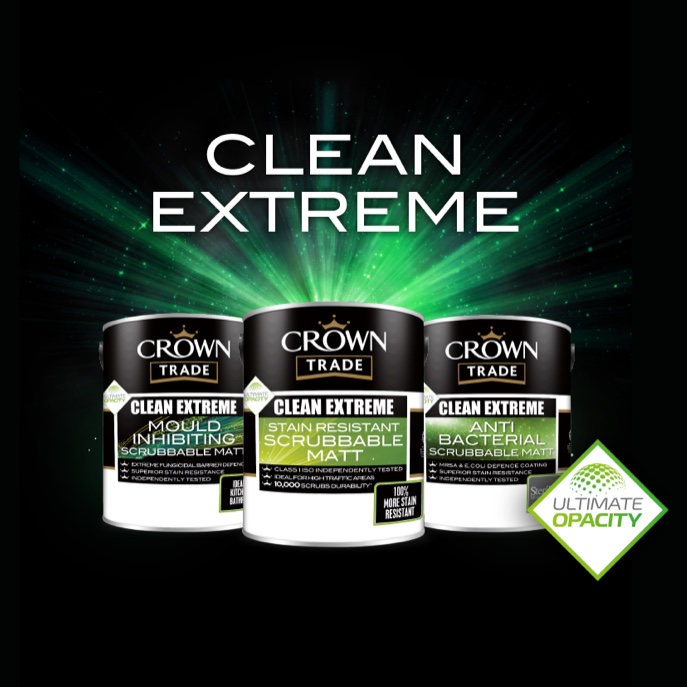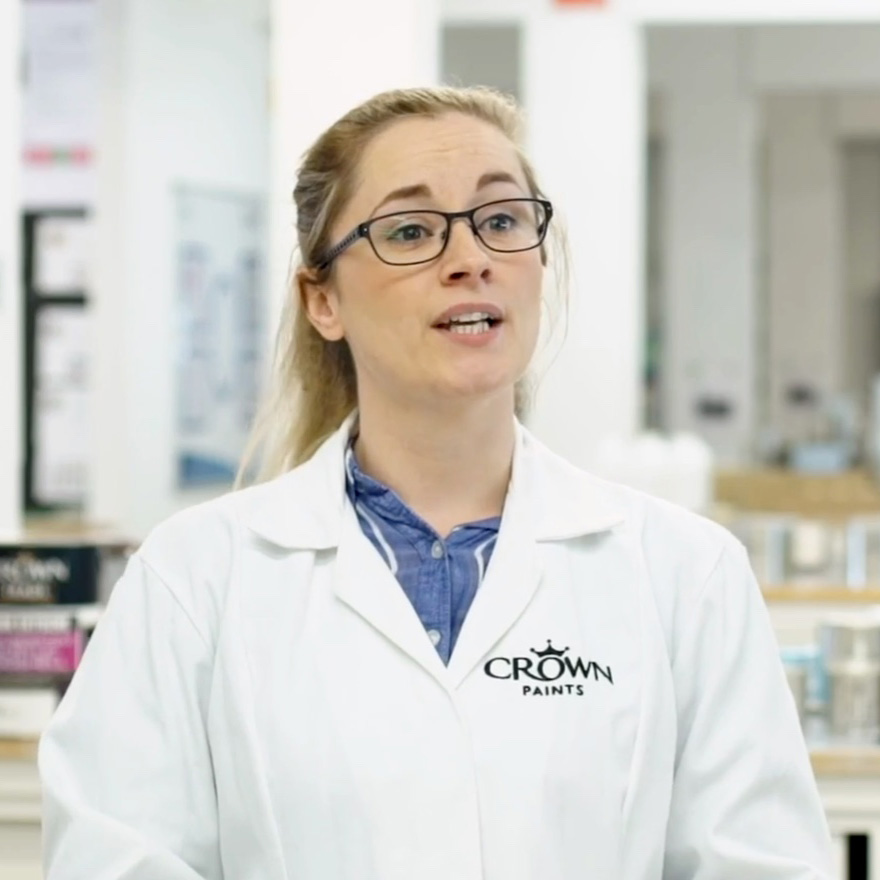First of all you need to try and identify where the water is coming from that is causing the damp area that the mould is feeding on. Once you’ve stopped the water leak then treat the area with Sandtex Trade Fungicide, leave for 24 hours then wash down to remove all residue and allow to dry. You can then overcoat with a topcoat of your choice.
Get the answers to some of the most frequently asked questions that our team receive below…
General
I’ve got an area of mould that seems to be getting worse down my wall – how do I deal with it?
How do I deal with powdery surfaces that need to be painted?
Powdery surfaces are caused by the paint film being exposed to the elements – sometimes it can be simply washed down before painting, if this doesn’t remove all the chalking then simply seal the area with Sandtex Trade Stabilising Solution prior to painting.
I’ve used a competitors product and I had problems with the paint washing off – I was told it was due to me painting in November as it was a little colder and also we had a shower – is there anything I could do to avoid this next time?
Definitely – it sounds like the paint had not completely dried before wet weather came – try using Sandtex Trade 365 All Weather Masonry paint – specifically developed to use in adverse weather conditions, is rain resistant within 20 minutes.
Are there any Sandtex Trade products that I can use over Sandstone?
Sandstone varies dramatically in its porosity – you can apply certain Sandtex Trade products but you will need to check if the surface is sandy and quite porous. If this is the case then you will need to treat the area with Sandtex Trade Stabilising Solution first and then with a topcoat for example Sandtex Trade Xtreme Xposure Smooth or Sandtex Trade High Cover Smooth.
Some of the paint on one of my exterior walls has started flaking off – what has caused this and how do I repair it?
There are two main causes for flaking – one could be overpainting grease, dirt or other contaminant or applying paint to a porous or powdery surface. It can also happen if you use a water-borne masonry paint over a solvent-borne paint. To overcome these problems with adhesion scrape away all the loose paint to a firm edge and abrade any glossy surfaces. For solvent-borne products it may be necessary to recoat in with another solvent based coating – for example Sandtex Trade 365 All Weather Masonry.
I’ve noticed that on some of my windows I’ve got a wrinkling in the topcoat – what has happened?
Sometimes the paint has been applied too thick but the main reason tends to be that you might have applied your topcoat before the first coat has thoroughly dried. You’ll need to scrape or sand the wrinkled topcoat down then repaint with your topcoat – but first of all you need to check whether that first coat has completely dried through. You need to take extra care in colder weather to allow extra time for the paint to dry completely.
On some of my doors outside I’ve noticed cracking appearing – only slightly – what can I do to stop it getting worse?
Well if you’ve caught it early enough and the cracking hasn’t gone too deep then it’s not too much of a problem. It could have been caused by you applying the paint too thick or maybe you applied it in cold weather or possibly if you’ve painted a gloss over a very flexible paint system that was currently on. The way to solve this would be to remove any loose or flaking paint with a scraper or stiff bristle brush (not wire), sand any edges, prime the area and then repaint it. If the cracks have gone deeper then you’ll need to remove all the paint – right down – either by scraper, sanding or even using a heat gun – then primer and paint. Try using Sandtex Trade Flexigloss X-tra for added peace of mind.
I’ve applied some gloss to my windows outside and they’re already starting to lose their gloss – what’s happened?
You’ll find many types of paint lose their gloss over a length of time but sometimes lower quality paints or paints that were meant for indoor use can lose it quicker than others. Sandtex Trade exterior gloss systems are specially formulated so that the binder and pigments are extremely resistant to UV attack and will keep its sheen level for longer.
Do I always need to use a primer on my wood and metal surfaces?
Yes, you do to provide a good key for the topcoat to adhere to, it can help seal surfaces and stops the topcoat from absorbing into the surface thus ensuring the durability and finish you desire.
I’ve got some normal wood primer that I haven’t used yet – is it ok to use this instead of the Flexible Primer Undercoat that I’ve been recommended to use with the Flexigloss X-tra I’ve bought?
It is key to use the Flexible Primer Undercoat as there are elements to this product that a normal interior wood primer would not have. It is flexible which will accommodate movement in the wood and temperature changes. It is also developed to work as part of the system that has gained the BBA endorsement of 8 years to guarantee the durability of the system.
Do I need to use a timber preservative before I stain my wood?
Many hardwoods (e.g. oak, teak and iroko), are naturally durable, and have their own natural resistance to decay/rot. Most softwoods and “cheaper” hardwoods are not durable, and must be treated with a preservative if they are to be used outside. Some of these timbers are treated in the factory to stop them rotting, but if this has not been done, Sadolin Wood Preserver and Quick Drying Wood Preserver are ideal for use as superficial preservative pre-treatments.
Why can’t I use white spirit to clean down surface prior to painting or woodstaining?
White spirit tends to smear contaminants such as grease, resin and oils over the timber surface rather than remove them. This is why we recommend the use of methylated spirits or cellulose thinners. White spirit can also have quite a ‘greasy’ feel to it and can add to problems with adhesion of subsequent coatings, especially water-borne ones.
There are a lot of knots in the timber I’m using. Should I use a knotting agent?
The phenomenon of resin exudation is natural and highly unpredictable, being dependent both on timber species and timber grade/quality. The traditional answer was to apply Shellac Knotting and ‘seal’ in the resin.
However, many years of research and on site experience have shown that this method is not completely effective, even with paints, with which it is traditionally used.
The moisture vapour permeable (sometimes referred to as microporous) finishes attempt to deal with the problem in a different manner by allowing resin to filter through the finish without blistering or peeling of the finish, hence full protection is maintained.
In the short term, resin exudation tends to look unsightly, but within a year or so the excess resin becomes exhausted and exudation ceases. The initial resin should be cleaned from the timber using a lint free cloth dampened with cellulose thinners or methylated spirits.
The new windows I’m coating already have a basecoat applied, do I just apply finishing coats of woodstain?
If the base satin is in a good condition and the windows have not been exposed for longer that about 12 weeks, then you would only really need to apply two coats of the finishing woodstain such as Sadolin Extra. Many base stains are formulated to offer only temporary protection to the timber during installation of the windows and if they have been exposed to weathering for more than 3 months then it would be best to sand back to bare timber and apply the full coating system, such as Sadolin Classic followed by Sadolin Extra.
What are the best fixings to use with Sadolin woodstains?
Because of the vapour permeable nature of Sadolin wood stains, iron or steel nails are not ‘sealed off’ from air and moisture, thus rusting of the nails can still occur. Rainfall then washes the rust away, and is seen as a brown ‘tear-like’ discolouration of the timber.
Any loose or rusty nails, screws, etc. should be replaced with galvanised or non-ferrous fixings, which will not corrode, even if exposed to the weather.
Wherever possible it is preferable to use lost head nails, but if this is impractical, nails should be punched home, and remaining holes filled with a suitable woodfiller.
My new timber has only been exposed for a few weeks and is dry and clean, can I just go straight ahead and apply your coatings?
As soon as timber is exposed to light, a substance known as lignin which binds together the timber fibres begins to be degraded. As this happens the fibres on the very surface of the timber become loose and friable.
Although this is not generally apparent to the naked eye, greying of exposed timber is a tell-tale sign that this is occurring. If these fibres are not removed by thorough sanding prior to coating under the stresses of weather they can detach from the main body of the timber taking the coating with them.
However, research has shown that even after only 2-3 weeks, and before any real colour change is seen, damage may already been done to these fibres and sanding is therefore recommended prior to coating.
Is washing down with water sufficient to remove the algal growth from the cladding before I re-decorate?
No, using water or an ordinary detergent will not kill off the spores present in the timber surface, even though the algal/mould growth may appear to be removed, and they would then grow through any newly applied coating.
You will need to use either a proprietary fungicidal wash or a solution of one part bleach to two parts water. This needs to be scrubbed onto the surface and allowed to ‘work’ for a minimum of 20 minutes before scrubbing off and rinsing with clean water. Allow to fully dry before decorating.
Can water-borne stains and paints be removed by burning off?
Yes, however, this is not an easy task. The preferred method would be to use a chemical stripper to soften the finish, remove with a metal scraper, followed by thorough sanding.
How do I remove lead paint?
Some old paint coatings may contain lead which is poisonous to humans, and before removing or preparing existing paint coatings it is important to determine whether the paint concerned contains lead. Remove all such coating materials in accordance with the appropriate legislation. A guide on “How to remove old lead paint safely” is available via the British Coatings Federation Ltd.
Do the shade cards and colour labels accurately represent the colour I will get on my joinery?
The shade cards and colour labels are only a general guide to the shade which will be achieved. The following factors all affect the final colour:
– The natural colour of the wood, and any existing coating,
– The texture and absorption of the surface,
– The way the products are applied.
I don’t want to colour the wood, I just want to protect it from the weather. What should I use?
Using a coating with no colour and expecting it to work well is like using sunglasses with no shading. In order to protect timber from the effects of sunlight (and ultra violet light in particular), it is necessary to reduce the amount of light reaching the surface.
In order to do this, the coating must contain a pigment/colour, which by nature will alter the appearance of the timber. In addition, clear finishes have less protection for themselves from sunlight, and may become brittle, peel and crack, leading to extra work at redecoration.
My windows are now very dark. I like the wood stain finish, but would like a lighter shade.
In order to highlight the natural features of timber, wood stains are translucent (i.e. semi-transparent). The final shade achieved is a combination of the colour of the surface to which they are applied, and their own pigmentation. A light coloured wood stain onto a dark surface will therefore always allow the dark colour to be seen, and thus the finish remains dark.
To achieve a lighter shade requires either stripping of the existing finish and re-coating, or the application of an opaque, paint-like coating like Sadolin Superdec.
What is the lowest temperature at which solvent-borne coatings can be applied?
It is not recommended to apply solvent-borne coatings when the temperature is likely to drop below 5°C during application and drying.
What is the lowest temperature at which water-borne woodstains can be applied?
It is not recommended to apply water-borne coatings when the temperature is likely to drop below 8°C during application and drying.
Are there special requirements for the application of water-borne coatings on timber substrates?
Water-borne coatings for wood are quicker drying and have different flow/levelling characteristics to traditional alkyd based (solvent-borne) coatings. It therefore recommended to use brushes designed for the application of water-borne coatings, and not to apply in extremes of hot or cold conditions.
Can water-borne coatings on wood be recoated with solvent-borne ones, or vice versa?
A water-borne coating is generally more flexible than a solvent-borne one, and the general rule if in any doubt, is “Preferably recoat water-borne with water-borne”. Provided, however, that the existing finish is sound and fully dry, there is no problem with overcoating solvent-borne with water-borne or water-borne with solvent-borne.
I’ve heard that Western Red Cedar can be difficult to coat, can I use your woodstains on some new cladding?
For a low sheen finish, three coats of Sadolin Classic would be an appropriate treatment for Western Red Cedar.
I have used another woodstain in the past, can I now use Sadolin to redecorate?
Providing the surface is sound, there will be no problems in applying these woodstains. Any peeling or flaking areas must be removed, and any bare timber thoroughly sanded back to clean, bright wood. Bare areas should be patch primed with a basestain such as Sadolin Classic to even up the colour, and then one or two coats of Sadolin Extra can be applied.
How much woodstain will I need to treat my windows and doors?
On average, every litre of woodstain will give two coats, indoors and out, on two partly glazed doors or four windows.
How do I remove any spillage?
Care should be taken to avoid spillages on to glass, cement, brickwork, carpets, clothing etc. If spilled, the solvent-borne coatings should be removed immediately while wet using white spirit. Water-borne coatings should be removed using a warm detergent solution. Once dry, the coatings will be very difficult to remove without damage to the surface.
What is the difference between a high solids, low solvent woodstain and a traditional solvent-borne coating?
High solids coatings differ from conventional stains on the following points: Lower emission of volatile organic compounds (VOCs); greater absorption/penetration into the timber surface, giving improved adhesion; greater flexibility to cope with timber movement; slower initial drying giving a longer open time and better flow/levelling characteristics; superior protection with the application of two coats instead of three.
I expected to use two litres of woodstain on my last job but only needed one. Why is the coverage rate quoted on your tins different from what I achieved?
The coverage rate we quote is a recommended coverage rate, which means that the product should be applied at this rate even though we know it can be brushed out further. If you achieve too high a coverage rate then it means that the finish has been applied too thinly.
Woodstains are formulated to become thinner and thinner as they weather, which makes them easy to maintain, but if applied too thinly it will mean that more frequent maintenance will be required.
I have stained a teak table and some iroko seating with Sadolin Classic and the coating is still not dry after two days. What is wrong?
Teak, in common with several exotic hardwoods, is a naturally oily timber. These oils retard the drying of all surface coatings, and will also impair the adhesion of applied finishes.
They must be thoroughly removed from the surface prior to decoration, and this can be effected by thoroughly rubbing the timber surface with a lint free cloth dampened with cellulose thinners or methylated spirits, changing the face of the cloth regularly. Although Iroko is not oily, it contains natural chemicals which have a similar effect to the oils in teak, and the surface should again be thoroughly degreased before coatings are applied.
High solids coatings such as Supercoat and One Coat are more susceptible to this problem than traditional coatings.
I decorated my windows with woodstain a year ago, but it is peeling off the putty, which is dry and cracked. Why is this?
The use of linseed oil putty for glazing in conjunction with Sadolin timber protection is not recommended. Putty contains drying oils which are necessary in order for the compound to remain pliable.
These oils migrate into the timber and oxidise with the atmosphere unless the compound is sealed by a film-forming system, such as a traditional gloss paint. Sadolin woodstains are moisture vapour permeable, and therefore do not seal the glazing compound. The resulting loss of the oils allows the glazing compound to dry and crack, causing a failure of the glazing seal.
For this reason we recommend the use of approved elastomeric sealants (polysulphide, silicone or acrylic).
Some plywood soffits looked great when I stained them with Sadolin Classic a few months ago, now they look as though they’ve gone mouldy. What has happened?
The white deposits found on the plywood surfaces are sodium salts which originate from within the glueline of the plywood. During the board manufacture, caustic soda is added to the glue mix to render the adhesive more soluble in water. Once the glue is cured, the caustic soda becomes superfluous.
Under the influence of atmospheric moisture, it can migrate to the plywood surface and appears as a white crystalline powder. In the normal course of events, the action of rainwater washes these salts away and they are rarely visible. However, in sheltered areas, such as soffits, the salts are not removed by rain action and remain as a ‘bloom’ on the surface.
The remedy for this is to wash down the affected areas with clean water and a bristle brush (not metallic bristles), thereby removing the salts. Provided that the finish is not damaged by over-vigorous scrubbing it need not be re-treated. It may, at some time in the future, reoccur to a lesser extent before the salts are fully depleted. Again, removal is by washing.
This phenomenon seems to vary with the type of plywood and country of origin. It should be pointed out that the loss of these salts in no way affects the strength or integrity of the plywood and does not blister or crack the finish.
In warm, dry conditions, Sadolin Extra is touch dry within a couple of hours. Can I apply another coat the same day?
The simple answer is NO. Water-borne stains, paints and emulsions can be overcoated as soon as they are fully dry, and two coats can be applied in the same day. Solvent-borne coatings undergo a two-stage process – firstly the solvent evaporates away (within 2-4 hours), leaving the surface dry to the touch; the coating then undergoes “oxidative curing”, i.e. the resin/binder within the coating reacts with oxygen in the atmosphere to give a chemically hardened (or cured) surface.
This process takes as long as 12 hours, and it is therefore essential that the coating is left to dry overnight before overcoating. Applying the second coat too soon can lead to wrinkling and a soft finish which can be easily damaged.






